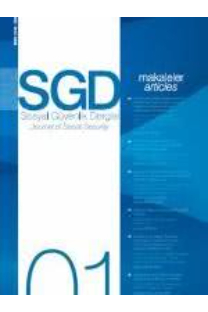Ülke Örnekleri ile Türkiye’de Yarı Zamanlı Çalışmanın Görünümü
Part-Time Work in Turkey with Country Examples
___
- Abhayaratna, Joanna; Andrews, Les, Hudan Nuch, Troy Podbury (2008), Part Time Employment: The Australian Experience, Melbourne: Productivity Commission Staff Working Paper.
- Çalışma ve Sosyal Güvenlik Bakanlığı (2014), Ulusal İstihdam Stratejisi, Ankara. Eurofound, Part-Time Work in Europe, [www.eurofound.europa.eu], (04.08 2017).
- European Parliament (2016), Precarious Employment in Europe: Patterns, Trends and Policy Strategies, Brussels: European Parliament Report.
- European Parliament (2017), Employment and Social Situation in the USA, Brussels: European Parliament Report, No: 2017-01.
- Eurostat, “Hourly Earnings by Economic Activity and Contractual Working Time (Enterprises with 10 Employed Persons or More), 2014”, [ec.europa.eu], (04.08.2017).
- Eurostat, “Part-time Employment Rate, 2016”, [ec.europa.eu], (04.08.2017).
- Fagan, Colette; Norman, Helen, Mark Smith and Maria C. Gonzalez Menendez (2014), In Search of Good Quality PartTime Employment, Geneva: ILO Conditions of Work and Employment Series, No: 43.
- Horemans, Jeroen (2017), Atypical Employment and in-Work Poverty: A Different Story for Part-Timers and Temporary Workers?, Antwerp, CSB Working Paper, No: 17/01.
- ILO (2017), World Employment and Social Outlook: Trends for Women 2017, International Labour Office, Geneva. ILO (2017), Unemployment Rate: ILO Modelled Estimates: 2016, [http://www.ilo.org/ilostat, 2017], (09.10.2017).
- Kalkınma Bakanlığı (2013), İllerin ve Bölgelerin Sosyo-Ekonomik Gelişmişlik Sıralaması Araştırması (SEGE) 2011, Ankara.
- Kalkınma Bakanlığı (2013), Onuncu Kalkınma Planı: 2014-2018, Ankara.
- Kyyra, Tomi; Arranz, Jose M. and Carlos Garcia Serrano (2017), Does Part-Time Work Help Unemployed Workers to Find Full-Time Work? Evidence from Spain, Bonn: IZA Discussion Paper Series, No. 10770.
- Matteazzi, Eleonora; Pailhe, Ariane and Anne Solaz (2013), Does Part-Time Employment Widen the Gender Wage Gap? Evidence from Twelve European Countries, Verona: ECINEQ Working Paper Series, No: 2013-293.
- Maurizio, Roxana (2016), Non-Standard Forms of Employment in Latin America: Prevalence, Characteristics and Impacts on Wages, Geneva: ILO Conditions of Work and Employment Series, No: 69.
- Nguyen, Huu-Chi; Nguyen-Huu, Thanh Tam and Thi-Thuy-Linh Le (2016), NonStandard Forms of Employment in Some Asian Countries: A Study of Wages and Working Conditions of Temporary Workers, Geneva: ILO Conditions of Work and Employment Series, No: 69.
- OECD (2016), OECD Employment Outlook 2017, Paris: OECD Publishing.
- Powell, Andrew and Federico Mor (2017), Women and the Economy, House of Commons, London: Briefing Paper; No: CBP06838.
- Robotham, David (2012), “Student Part Time Employment: Characteristics and Consequences”, Education and Training, V. 54 (1): 65-75.
- SGK (2017), “İşyeri ve Sigortalılara Ait İstatistikler: 2015”, [www.sgk.gov.tr], (05.08.2017).
- TİSK (2009), 4857 Sayılı İş Kanunu ve Gerekçesi, Ankara: Türkiye İşveren Sendikaları Konfederasyonu Yayınları, Yayın No: 293.
- TÜİK (2017), “İllerde Yaşam Endeksi: 2015”, [www.tuik.gov.tr], (05.08.2017).
- TÜİK (2017),“İşgücü İstatistikleri: 2007- 2016”, ”, [www.tuik.gov.tr], (05.08.2017).
- Veliziotis, Michail; Matsaganis, Manos and Alexandros Karakitsios (2015), Involuntary Part-Time Employment: Perspectives from Two European Labour Markets, Brussels: Improve Working Paper, No. 15/02.
- Wilson, Lisa (2017), Patterns and Trends in Employment Arrangements and Working Hours in Northern Ireland, Ireland: NERI Working Paper Series, No: 45.
- World Bank (2012), Jobs, Washington: World Development Report 2013.
- Zukin, Cliff and Carl Van Horn (2015), A Tale of Two Workforces: The Benefits and Burdens of Working Part Time, New Jersey: John J. Heldrich Center for Workforce Development.
- ISSN: 2146-4839
- Yayın Aralığı: 2
- Başlangıç: 2011
- Yayıncı: SOSYAL GÜVENLİK KURUMU
Finansal Kuznets Eğrisi Hipotezi: G-7 Ülkeleri Örneği
Hastanelerde Maliyet Analizi: Kamu Hastanesi Örneği
EMEL İSLAMOĞLU, SİNEM YILDIRIMALP, ERDEM CAM
Türkiye’de Kadın İstihdamı ve Aile: Algılar ve Teori Arasında Bir Karşılaştırma
İşyerlerinde ve İşletmelerde İş Sağlığı ve Güvenliği Hiyerarşisi
Kadınların İş-Aile Yaşamı Çatışmasını Engellemeye Yönelik Hukuki Düzenlemeler
Türkiye’de Ev Eksenli Çalışan Kadınların Hukuki Durumları
Ülke Örnekleri ile Türkiye’de Yarı Zamanlı Çalışmanın Görünümü
İşsizlik Oranı Üzerindeki Şoklar Gerçekten Kalıcı mı: Türkiye Ekonomisi Üzerine Bir Analiz
TÜRKER TOPALHAN, Ömer Tanju DURUSOY, ZEYNEL ABİDİN ÖZDEMİR
